
|
|

I
took over this e-zine when Gail, its originator was unable to continue it. With
Gail's permission, I have added her original Rock's of the Week so that everyone
can find the information readily. Please feel free to visit Gail's web site at http://www.davesrockshop.com. |
|
Emerald
(May birthstone)
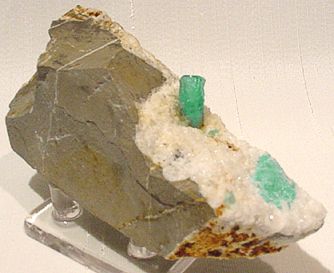
Emerald crystals from Coscozz Mine, Columbia
|
|
Scientific:
The name Emerald is of ancient origin. The Latin or Greek name
"Smaragdus" means green stone and appears to have referred to all green stones in ancient times. Emeralds are now considered as a distinct species all of their own.
Emerald is a green form of beryl. It is the most precious stone in the beryl family. Other stones in the beryl family include aquamarine (bluish-green), bixbite (red),
heliodor (yellow), and morganite (pink). Not all gem quality green beryls are called emeralds only those stones that are green due to the presence of chromium. Green beryl colored by vanadium and not chromium is not emerald but are simply green beryl.
Emerald crystallizes in the structure of prismatic crystals, sometimes vertically striated and terminated by small pyramid-like faces, as well as hexagonal, and hexagonal prisms. |
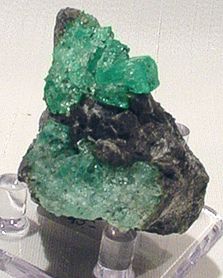
Emerald crystals from Coscozz Mine, Columbia
|
Emeralds can be light or dark green, bright green or leaf green or slightly yellowish green. Color distribution is often irregular. A dark slightly bluish green is most desired. Only the finest specimens are transparent. The pleochroism of emeralds is definite; from green, blue green to yellow green. Only occasionally do emeralds
fluoresce.
The vitreous luster is not outstanding and is strongest in medium light stones with few inclusions. All emeralds contain inclusions although in the best quality stones these inclusions are very faint and not visible to the naked eye. These inclusions can be seen using a jeweler's loupe of at least 10X. These inclusions are not necessarily classified as faults but are evidence as to the genuineness of the stone as compared with synthetic or other imitations. These inclusions are referred to as jardin (French for garden).
The biggest and most beautiful emeralds come from the famous Chivor and Muzo Mines near Bogotá, Colombia where it occurs in black limestone. Recently quantities of medium light colored emeralds come from Brazil. These emeralds have very few inclusions. Small very intense colored stones come from the Transvaal, South Africa. Recently small deposits have been found in East Africa, principally in Zimbabwe, Zambia and Nigeria, Tanzania. Emeralds are also found in the mountains of India,
Norway, Afghanistan, Pakistan, Russia and Bavaria and Austria. Emeralds are also found in Australia, Ghana, Madagascar, Malawi, Mozambique, Egypt, Namibia and North Carolina in the USA. |
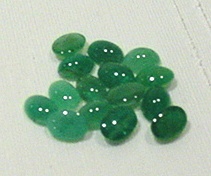
Emerald cabs
|
Stones of good color weighing more than 2 carats are among the most highly valued gemstones and their price may equal or exceed that of diamonds. Stones that are too light or too dark or slightly turbid are usually quite a bit less.
The color of emerald is very stable against light and heat and only alter at temperatures between 1292 and 1472 degrees F. Emeralds are very brittle and sensitive to pressure because they have internal stress. Care must be taken when heating or setting these stones. However, they are resistant to all chemicals that are normally used in the household. It is common practice to oil emeralds to disguise the tiny flaws including fractures and inclusions.
The most common shape for gem cutting emeralds is the step cut or trap cut, which is also known as the "Emerald cut" although other cuts are also used. Cameos, intaglios and beads can make the best of a flawed stone.
Hardness: 7.5 - 8
Chemical Composition: Be3(Al,Cr)2Si6O18 or
Al2Be3Si6O18
Aluminum beryllium silicate with traces of chromium produce the green color of emeralds. |
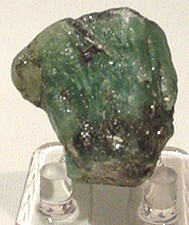
Emerald crystal from Russia
|
History:
It was first found in calcite veins and mined by the Incas. At the time of the Spanish conquest of Peru in 1531, an Emerald Goddess,
Umina, dominated the Peruvian city of Manta. Her image was an enormous emerald crystal. Her priests had collected a great store of her "daughters," smaller emeralds offered by the faithful. The conquistadors seized all this booty. Their missionary priest, Fray Reginaldo de
Pedraza, encouraged the soldiers to "test" the stones by smashing them with hammers, for he claimed that real emeralds would not shatter and those that broke were only imitations, inhabited by devils and fit only for destruction. He did not subject his own gems to this test but sold them later for high prices. |
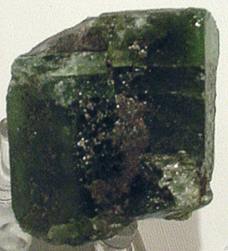
Emerald crystal from Russia
|
The Romans are known to have imitated emeralds with skillfully worked green glass.
Emperor Nero had a famous emerald through which he watched the gladiator games.
There are many very famous large emeralds kept in many museums around the world including the 4.5 inch 2200 carat vase carved from a single crystal in the Viennese Treasury. |
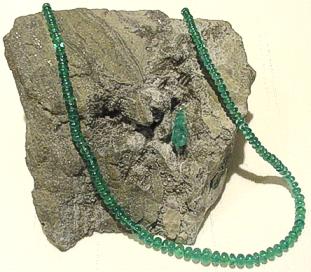
emerald necklace with emerald crystal in matrix
|
Lore:
Emeralds were sacred to the Great Goddess, symbolizing her green-clad earth in spring festivals.
Emerald remained the stone of Venus, or Aphrodite, to be worn on her holy day, Friday.
Her Greek consort Hermes, who became the god of magic because he was privy to her secrets, was said to have composed the famous Emerald Tablet, with the ultimate Words of Creation written on emerald. The Egyptians, who called him Thoth, said that his tablet was made of "matrix emerald." |
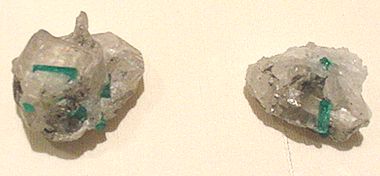
emerald crystals in quartz from Columbia
|
In the Middle Ages, Hermes became the mythical father of alchemy, Hermes
Trismegistus. His magical tablet became the mythical prototype of the Koran, in Arabian tradition the Preserved Tablet, or Mother of the Book.
The emerald's established sacredness led a biblical writer to describe the throne of God as surrounded by a rainbow that looked like an emerald (Revelation 4:3).
Rabbinic legend said that emerald was one of the four precious stones that God gave to Solomon.
Medieval tradition insisted that the Holy Grail was carved from a single huge emerald, which had fallen from Satan's crown during his descent from heaven to the underworld. |
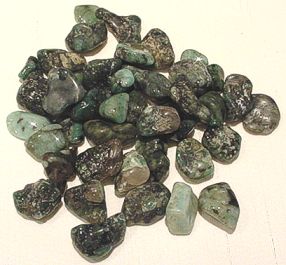
tumbled emeralds
|
Metaphysical:
The emerald symbolizes abundance and richness. It has been said that if one drinks emerald water for 3 days it will manifest those things that are most desired. Or, it is recommended that everyone should drink water in which an emerald has lain. This is an effective healing potion because "Emerald is a living energy field that represents universal intelligence."
The emerald should be worn alone for if it is worn with other stones its power can be diminished.
Emerald is known as a "stone of successful love". It is said to provide for domestic bliss and to instill sensitivity, loyalty and harmony within the self and within others. It can be used to open, to activate, and to stimulate the heart chakra. It has been used to help to quiet the emotions. It is a stone to bring harmony to all areas of ones life. |
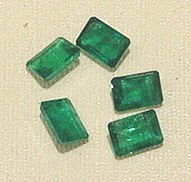
emerald cut emeralds
|
It can also assist in inciting one to activity and to facilitate intensity and focus in ones actions. It is said to give one the strength needed to take the positive actions needed to accomplish ones lifework or fulfill ones destiny.
Emerald has been used to eliminate negativity from ones life. It can help to bring awareness of the unknown to conscious recognition, helping one to access the laws of order within the universe and to eliminate from ones life that which impedes progress.
It has been called the "Revealer or truth". Sometimes emerald is regarded as the enemy of sexual passion. Therefore, this might not actually be the stone of the goddess of love... |
|












